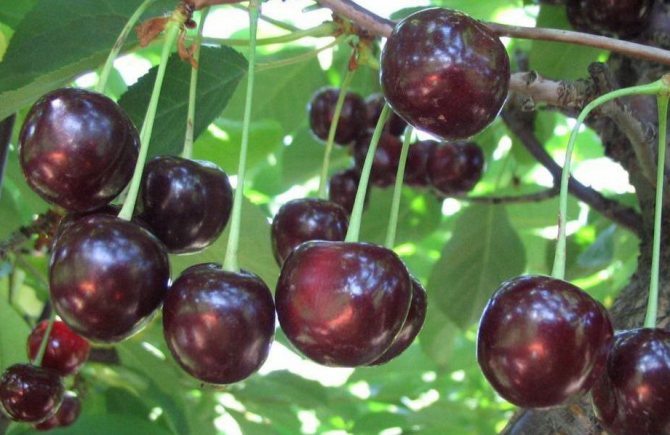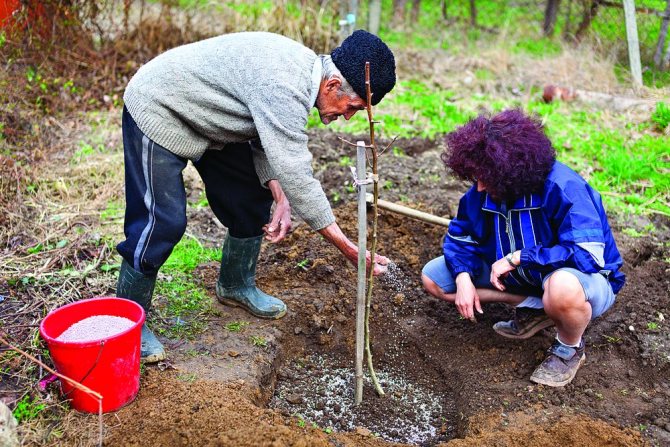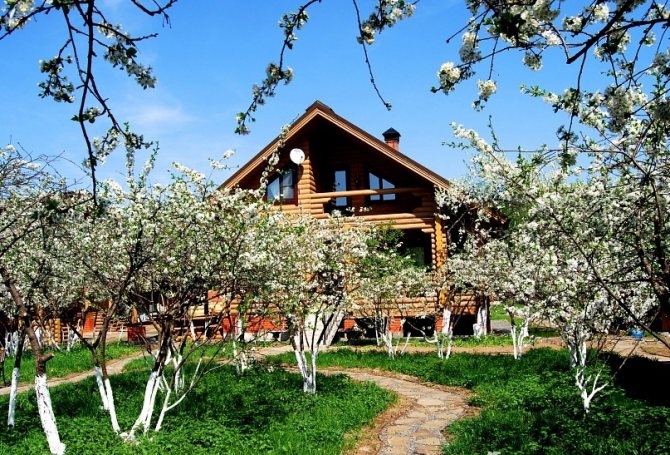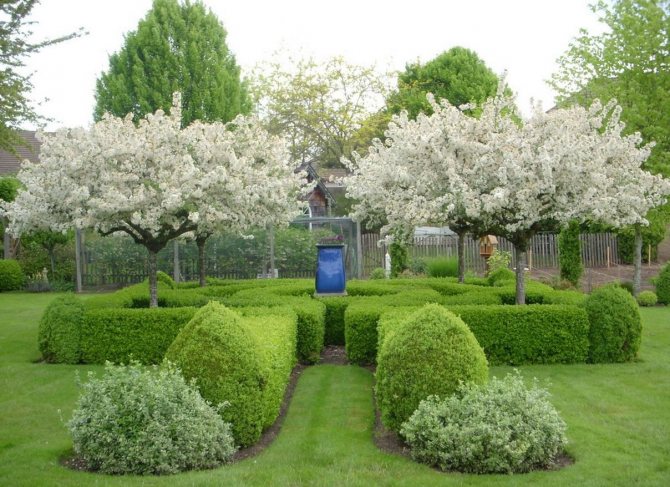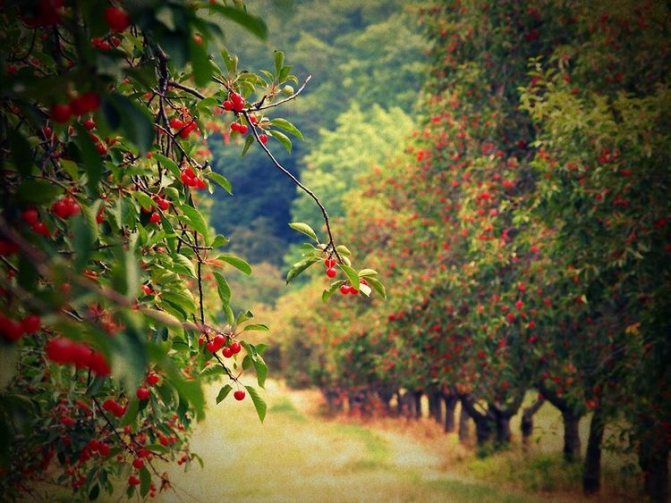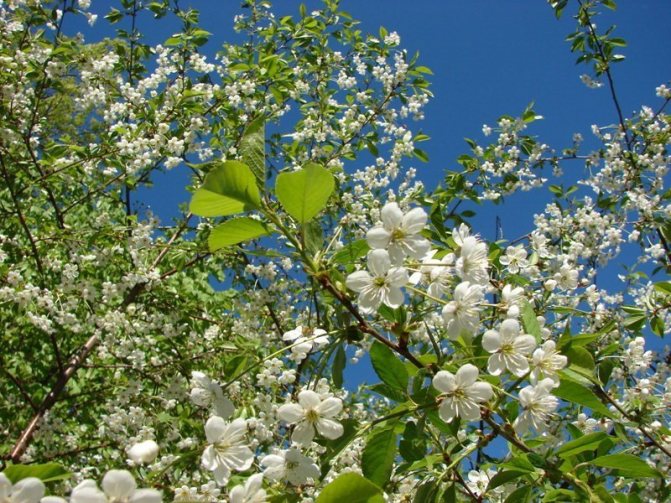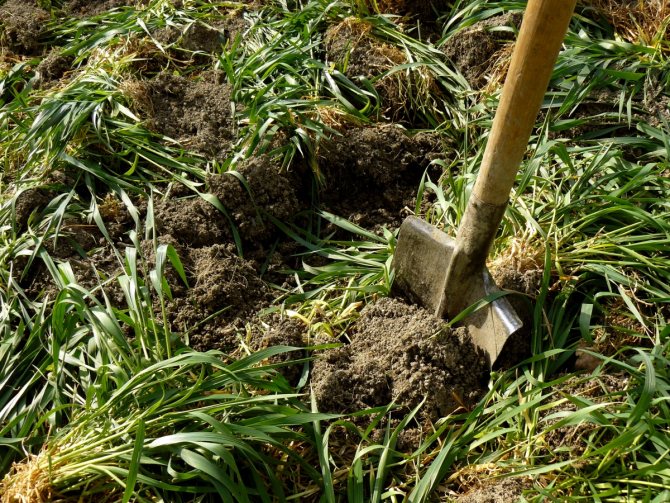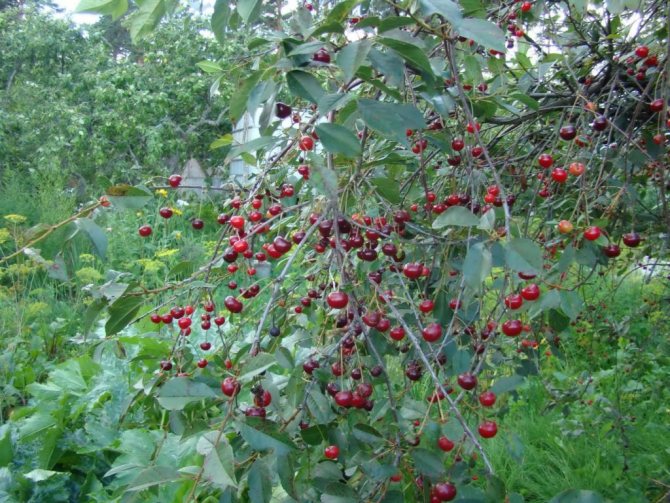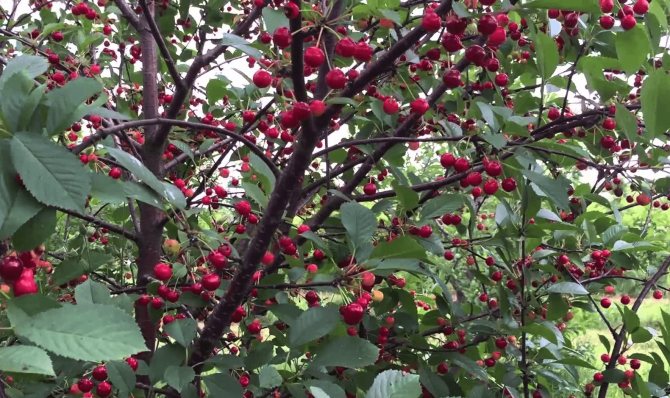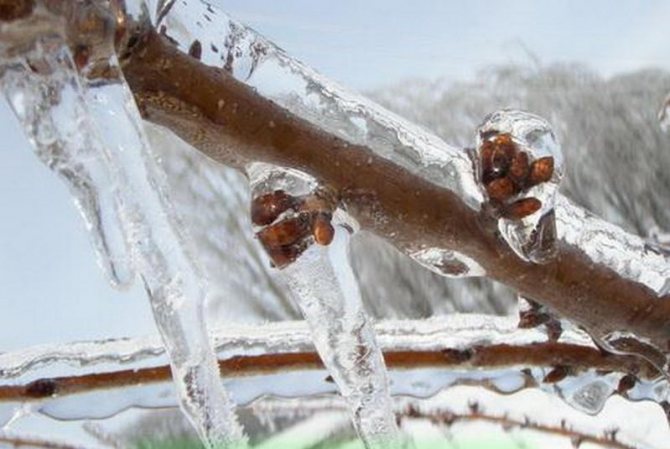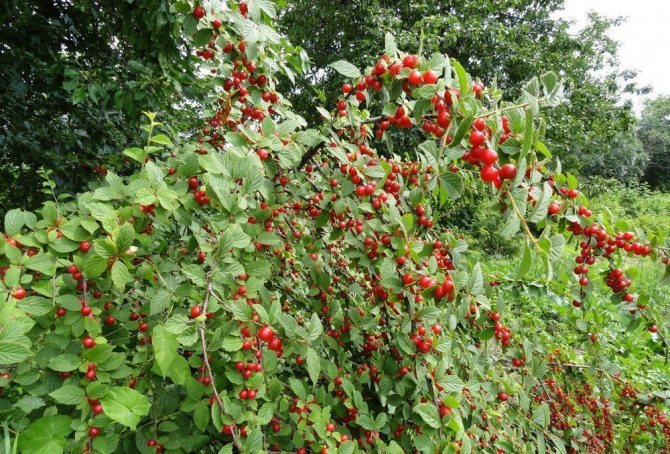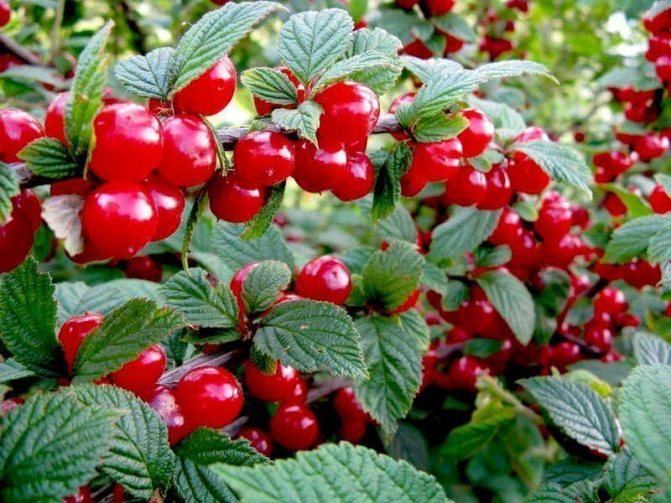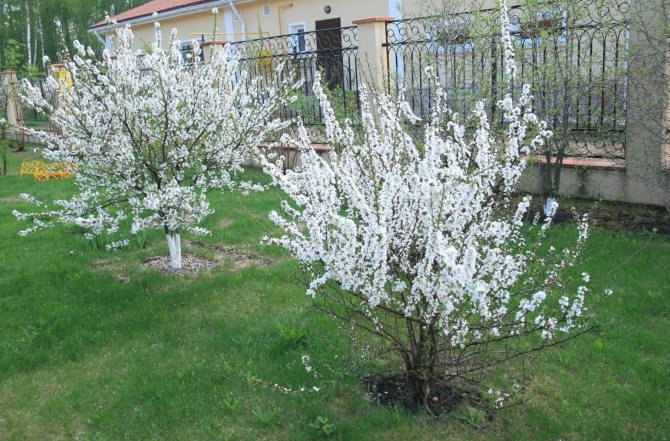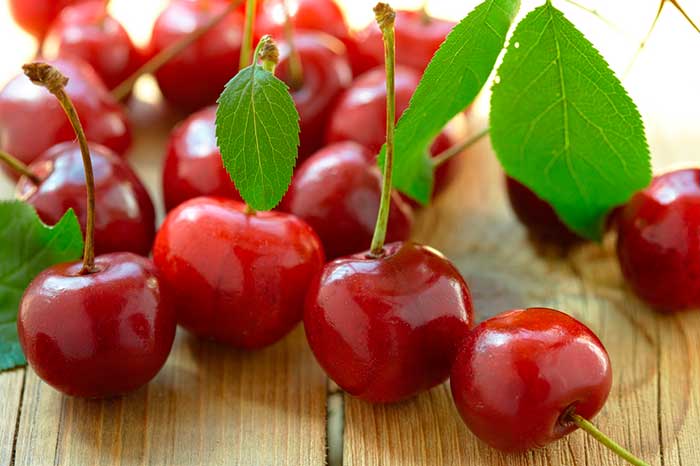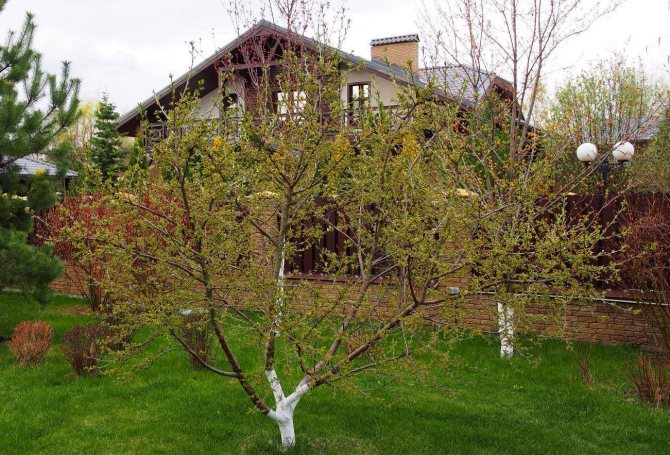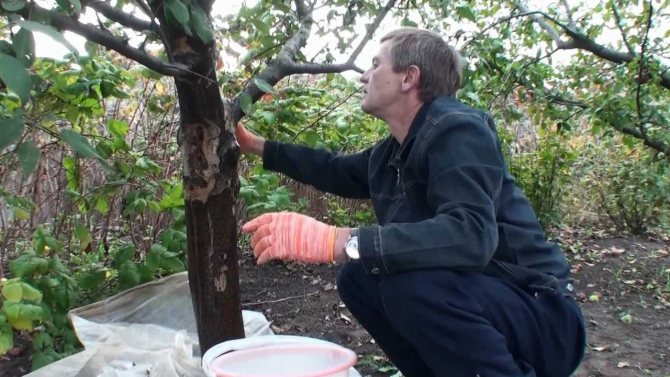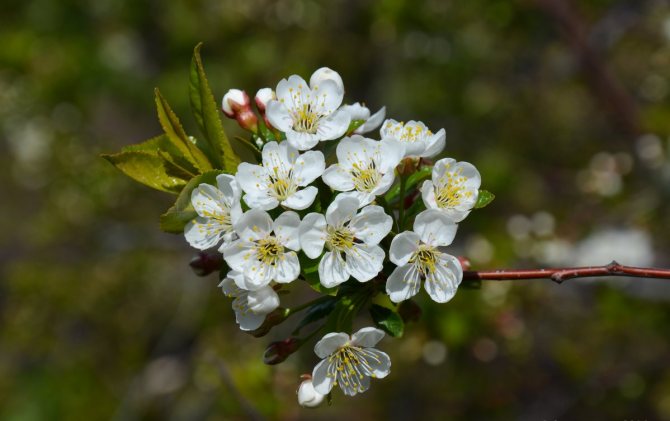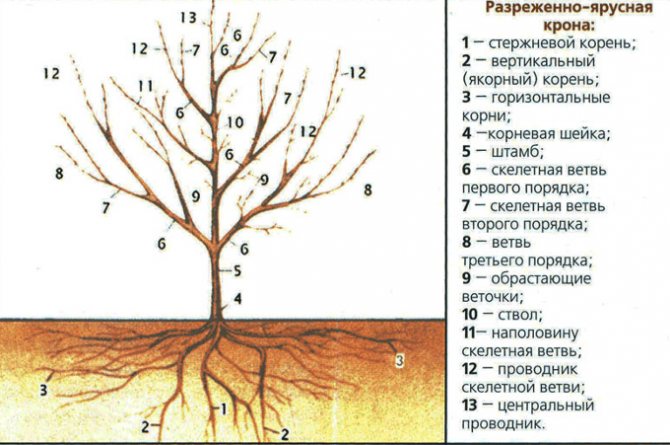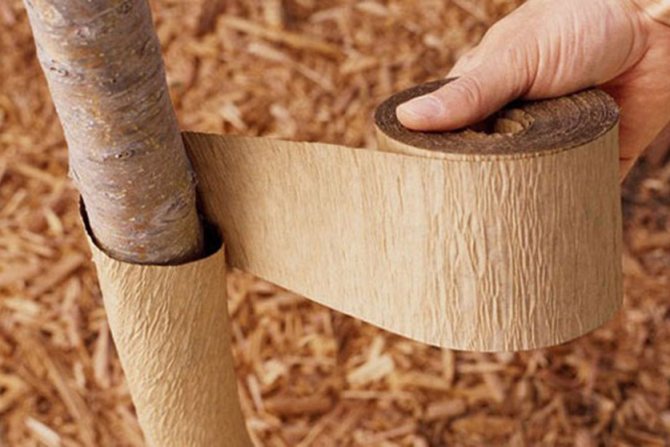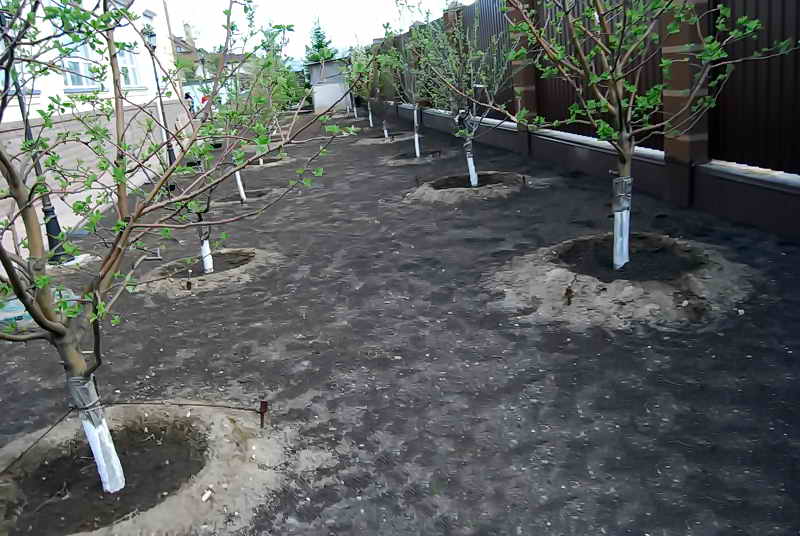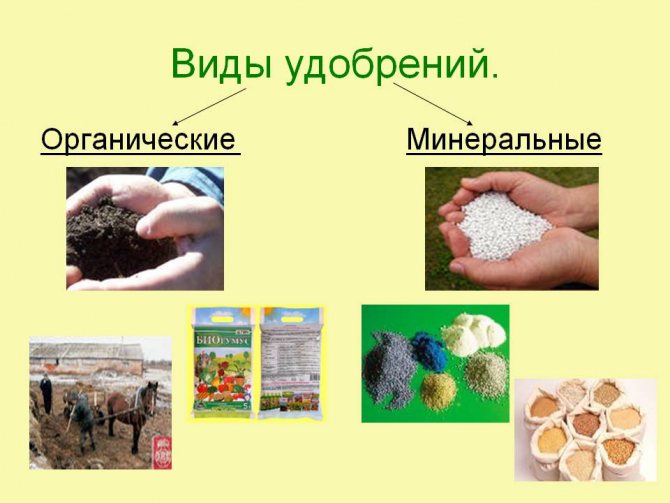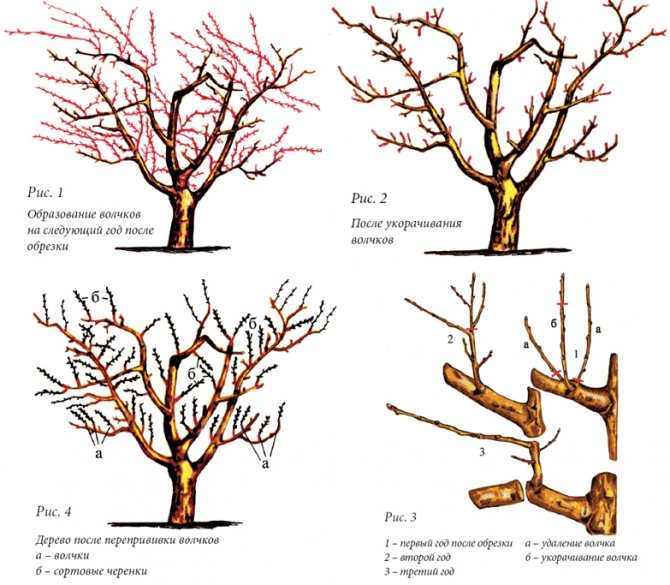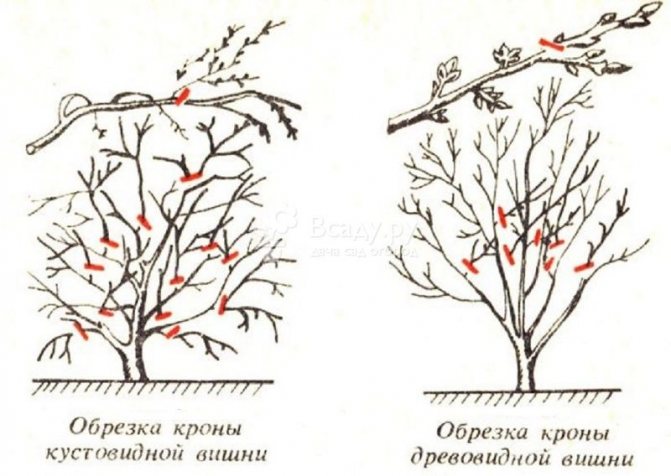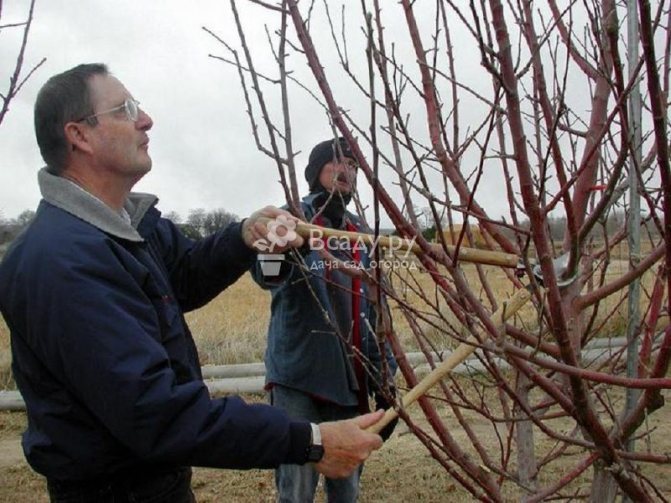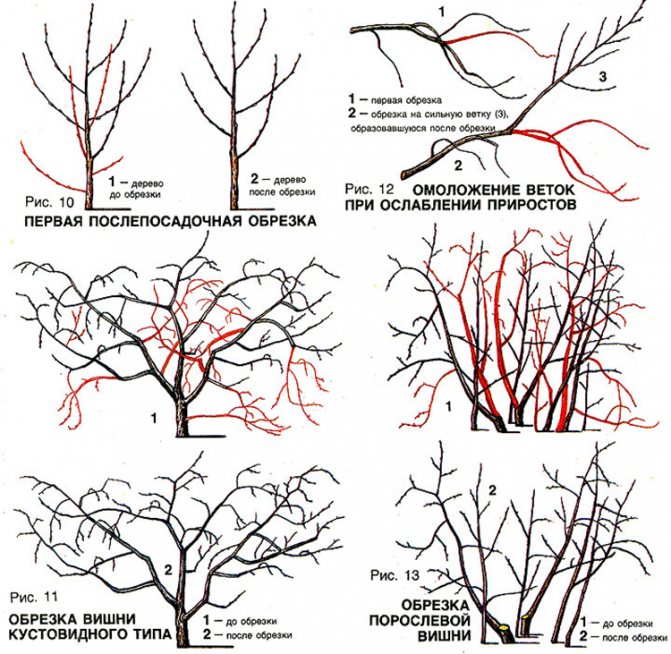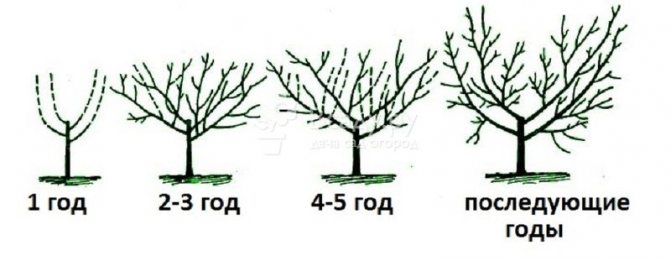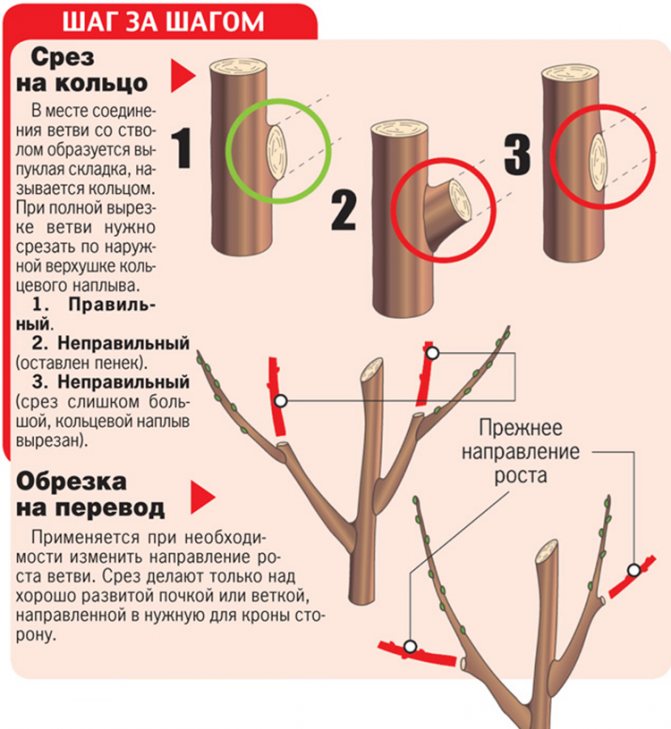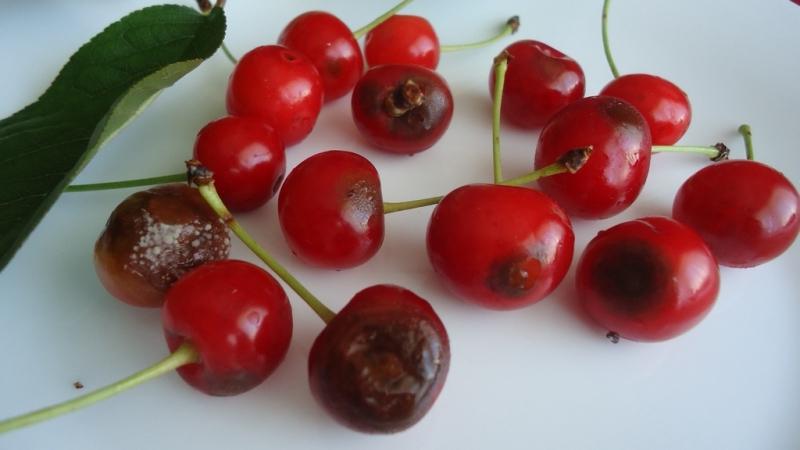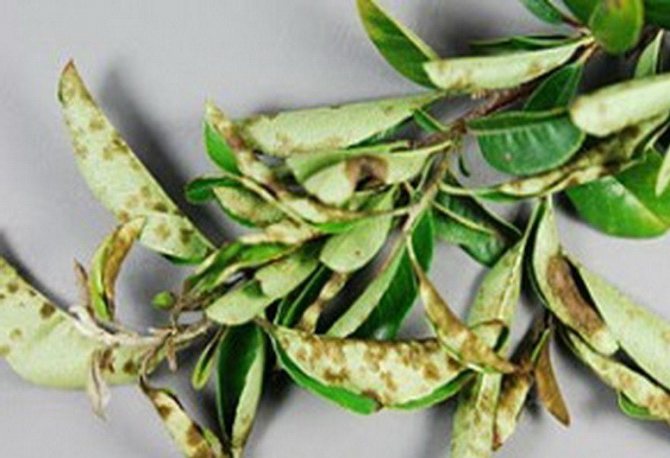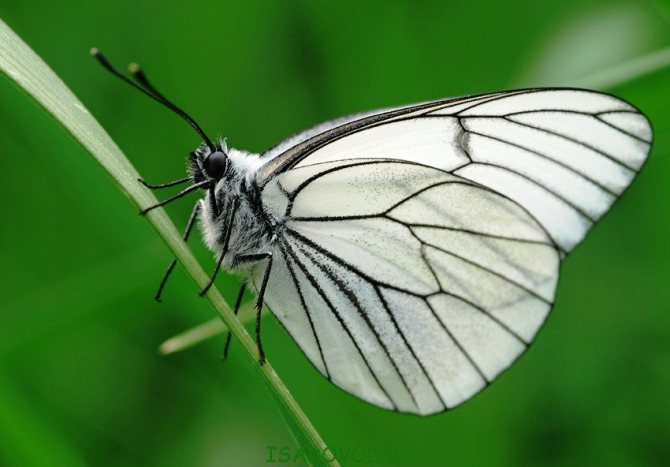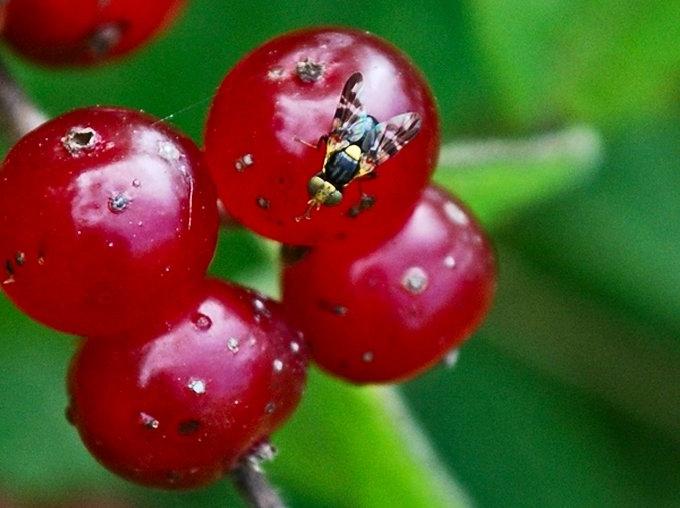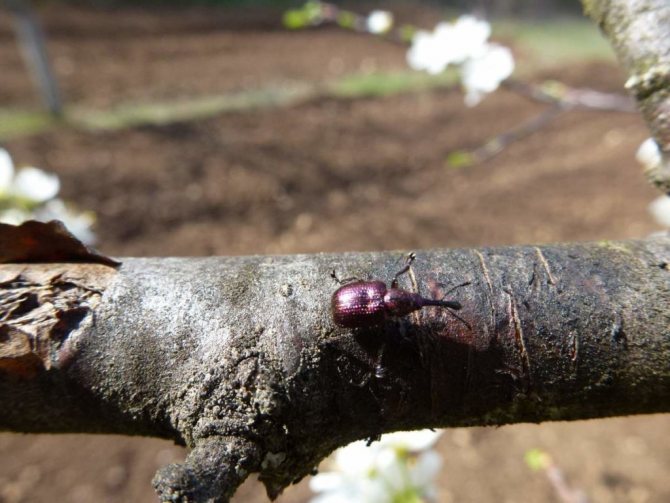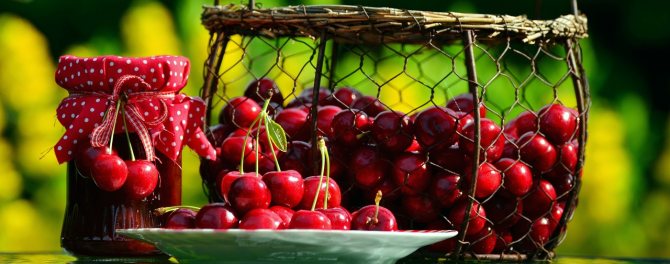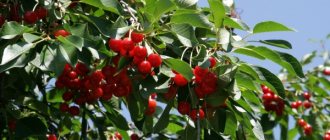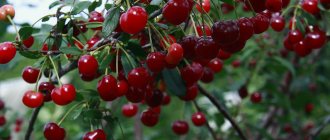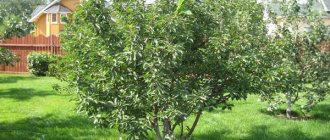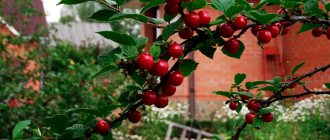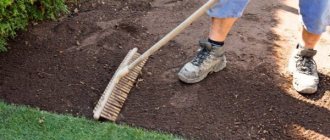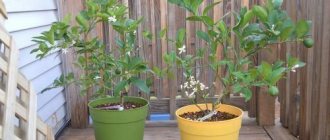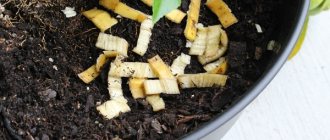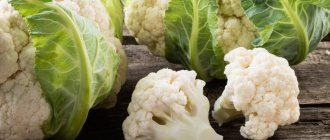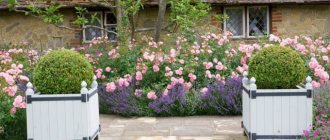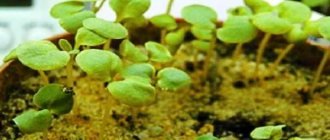Cherry is the most popular stone fruit crop found in our gardens. This is explained by its unpretentiousness and relatively uncomplicated tree care, as well as the great demand for fruits both fresh and canned (as preparations for the winter). But in order for the cherry to constantly bear fruit and not cause much trouble, it is first necessary to plant a fruit tree according to all the rules.
How to plant cherries correctly in spring, how to choose a good place for them in the garden and prepare a planting pit, you will learn from this article.
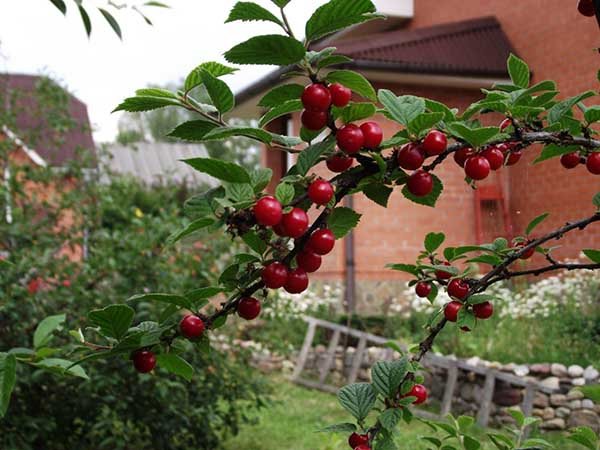
Cherry description
Cherry is a deciduous tree or shrub with a height of 2 to 7 meters. The bark of the tree has a gray-brown hue. Cherry leaves are petiolate, dark green in color, oblong, oval, pointed at the top of the shape. The length of the cherry leaf is up to 8 cm, the width is up to 5 cm. The cherry blossoms with white or pale pink flowers with a pleasant aroma, collected in inflorescences - umbrellas, which, during flowering, are luxuriantly dotted with the branches of the tree. Cherries blooming and fragrant in the garden are an incredibly beautiful sight.
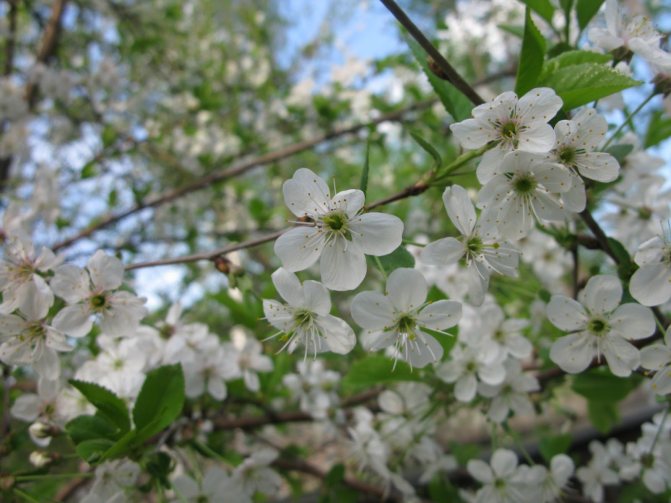

Cherry fruits are juicy drupes. Delicious, deep red shades of spherical berries with a sour or sweet-sour taste, rich in vitamins and minerals, can be eaten fresh, cooked compotes, jams, and used to prepare many delicious dishes. Cherries are perfectly stored both dry and frozen, while retaining all the beneficial healing properties.
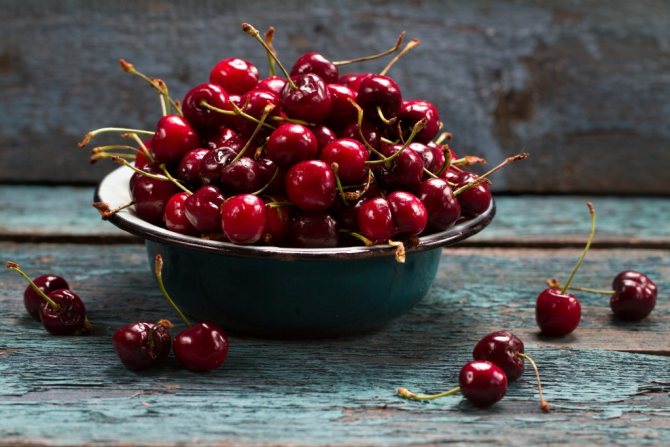

Basic information about cherries
The most common representative of the species is ordinary cherry. Does not grow in the wild. It has been cultivated for more than one century. Breeders tirelessly breed all new varieties, for example, Bessey, Vladimirsky cherry, dessert variety Iput, Molodezhny, Morozov, Sania, Turgenevka, etc.
According to its individual characteristics and structure, it is divided into two types: tree and bushy.
The bush form is characterized by a spherical crown, the branches are lowered, shoots are formed abundantly, the fruits are almost black in color. Subject to all the rules of agricultural technology and in optimal climatic conditions, it actively bears fruit for 10-18 years. The root system of a bush-shaped tree grows around 6-7 meters, does not lie very deep. This form has high rates of frost resistance, in contrast to the tree.
The fruit tree bears fruit with sweet and sour berries. They have a universal purpose: they are eaten fresh, added to baked goods, prepared compotes / jelly / liqueurs and much more, as well as dried and frozen.
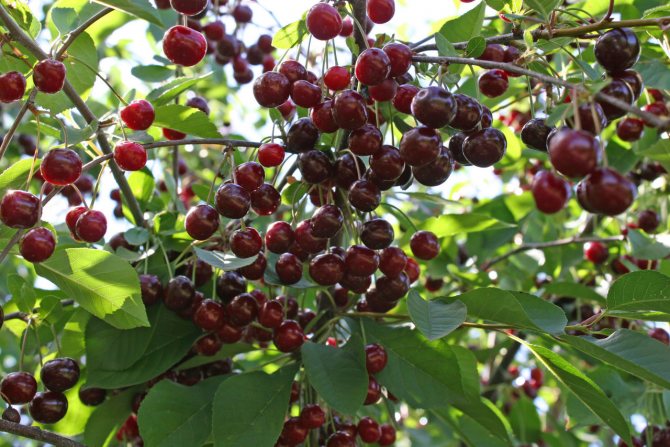

How many times does a cherry bear fruit
The fruit contains a high concentration of tannins, vitamins A, B, C and PP, organic acids, pectins, macro- and microelements, fructose, ash and nitrogenous compounds are present. Due to its chemical composition, the fruits are widely used in traditional medicine. The composition contains pectins that cleanse the body of toxic substances.
Important! When cooking cherry jam, seeds should be removed from berries, since they contain amygdalin. As a result of heat treatment, organic bonds disintegrate and poisonous substances are formed.
Useful properties of cherries for the body:
- Stimulates an increase in hemoglobin levels, lowers blood pressure and strengthens the capillary walls.
- An effective preventive measure against angina attacks, heart attacks, atherosclerosis, strokes and thrombosis.
- It is used to treat gout and arthritis, as it reduces the concentration of uric acid in the body.
- The composition includes copper, which is effective in the fight against mental illness.
- Fights the causative agents of dysentery, and is also active against streptococci and staphylococci.
- The composition includes a high concentration of pectins, so the berries effectively cope with constipation, remove toxic substances from the body.
- It is used in the form of expectorant and antipyretic drugs.
From the pulp, you can make masks that nourish and cleanse the skin well, tighten the pores.
Cherry varieties
In nature, there are more than 150 plant species, common in many European countries, North America and Asia. Most of them are domestic crops, bred by selective breeding. Wild cherry varieties are also common in nature.
Common cherry
It is a domestic culture that is practically not found in the wild, one of the most common species cultivated since antiquity. There are bushy and tree-like varieties. The common bush cherry has a spherical crown, the branches of which go down, shoots are abundantly formed in it, the fruits have a dark bright almost black hue. Bushy varieties bear fruit from 10 to 18 years. Frost-resistant species. Treelike varieties are a tall tree from 2 to 7 meters with a shiny dark bark with a luxurious spreading crown and branches. The leaves are oval in shape, with a pointed end of dark green color. Flowers - fragrant, white, collected in umbrellas, pollinated by insects. The fruit is a drupe (with a hard bone surrounded by red or burgundy pulp). The most popular varieties of ordinary cherries:
- Anthracite. A short tree with a dense crown of average yield. Fruits are large, maroon, almost black in color with dense juicy pulp, sweet and sour in taste.
- Victoria. The tree is medium in size, the crown has a rounded, slightly raised crown. Fruits are medium in size, rounded, spherical, dark red in color, with a long stem that can be easily separated from the fruit.
- Vladimirskaya. A bushy variety with good yields. Winter hardy. Fruits are large, dark in color, and have excellent taste.
- Youth. High-yielding frost-resistant bushy variety. The tree is undersized, with drooping branches. Fruits - maroon color, have a sweetish taste. Ripe berries can persist on the branches for a long time without falling off,
- Turgenevka. A tree-like winter-hardy variety, the tree can reach a height of up to 3 meters, the crown is raised. Fruits are large, juicy, dense, dark red.
- Chocolate girl. Winter-hardy and drought-resistant variety with rich burgundy berries, almost black. The taste of the berries is sweet, the pulp is of medium density.
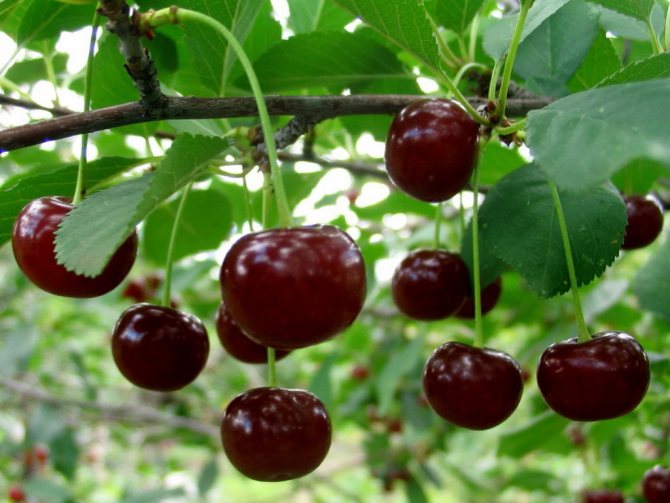

- An early ripe variety that begins to bear fruit in early June. Frost resistant. The fruits are juicy, sweet in taste, pink in color.
Steppe cherry
Frost-resistant species, widespread in the northern regions. It is a tree or undersized shrub with an extensive crown. The branches are erect, the leaves are oblong, slightly pointed at the top. It blooms with white small flowers, collected in a bunch. The fruits of the steppe cherry are small, juicy, with a pronounced sour taste, pink and boron. The berries ripen in late summer or early autumn. Famous varieties:
- Generous. A high-yielding variety with late ripening, winter-hardy and drought-resistant. Cherry fruits are dark red, sweet in taste, flesh is watery.
- Bolotovskaya.A highly self-fertile variety with late ripening (at the end of August), the fruits are large, juicy, have a rounded shape, the color is deeply dark red.
- Maximovskaya. High-yielding medium variety with large red fruits on long stalks. The taste of cherries is sweet and sour, juicy.
- Desired. An early variety with a high yield, large berries.
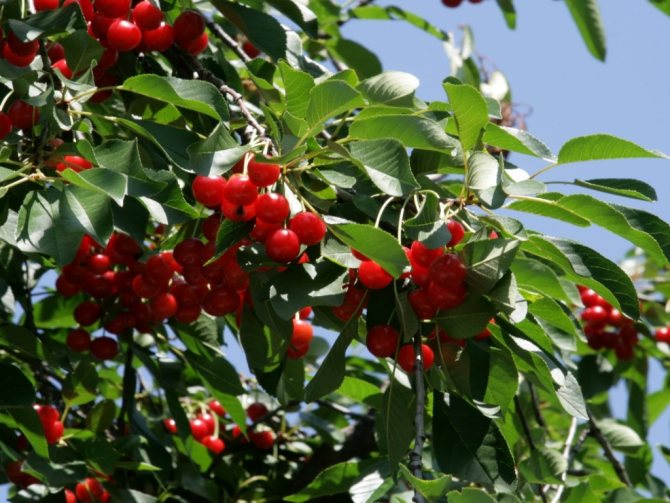

Felted cherry
A short tree or shrub (1 to 3 meters) with a luxurious crown. China is considered to be the homeland of the species, sometimes this type of cherry is called Chinese. The felt cherry blossoms incredibly beautifully - the branches of the tree are densely, from the very base of the branches to their tops, covered with pale pink flowers that bloom long before the leaves appear. For its attractive appearance during flowering, Chinese cherry is used for decorative purposes to decorate the garden. Felt cherry looks no less decorative during ripening - its branches, with bright juicy berries, surrounded by small velvet oval-shaped leaves with jagged edges, beautifully lean to the ground. The lower part of the leaves is slightly pubescent, due to this, the effect of their velvety is created, and resemble a felt covering, hence its name. This is a frost-resistant species, the fruits are small, juicy, sweet with a small stone, which does not separate from the berry. Ripe fruits can remain on the branches for a long time and not crumble, retaining their taste. The most famous varieties:
- Natalie. An early ripe high-yielding variety with berries with firm pulp.
- Princess. Low-growing shrub with high yields. The berries are bright pink, large.
- The dark-haired oriental. A mid-season variety with an average yield, Fruits are small, sweet and sour, burgundy in color.
- Anniversary cherry. Mid-season variety with medium-sized red juicy fruits. White. Mid-season variety with small juicy white fruits, with sweet and sour berries.
- Oceanic virovskaya cherry. Late high-yielding variety with firm sweet and sour fruits of medium size.
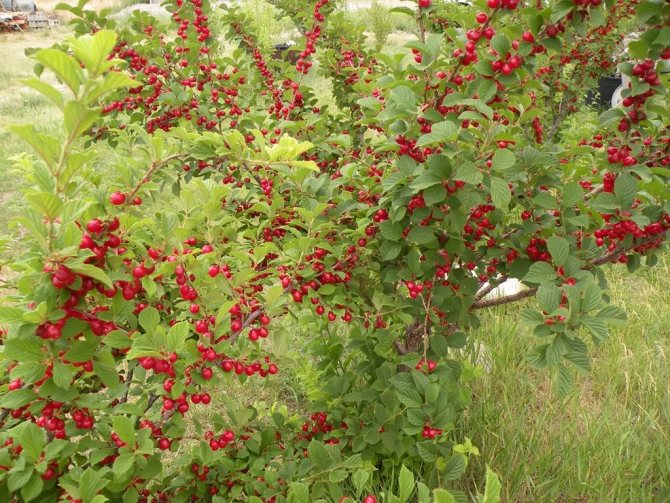

Japanese cherry or sakura
This decorative tree comes from Japan, where it is a kind of symbol of the arrival of spring. Blooming sakura is incredibly beautiful, the tree is simply strewn with delicate fragrant double inflorescences of pink shades. Sakura tree - tall, up to 4 meters with a luxurious spreading crown and long branches falling to the ground. The leaves are narrow, ovoid, pointed in shape, have a dark green color. For cultivation in our climatic conditions, frost-resistant varieties of Japanese cherry are used:
- Kanzan is an abundantly flowering cherry with bright pink double flowers that begin to bloom in May. The fruits are of medium size.
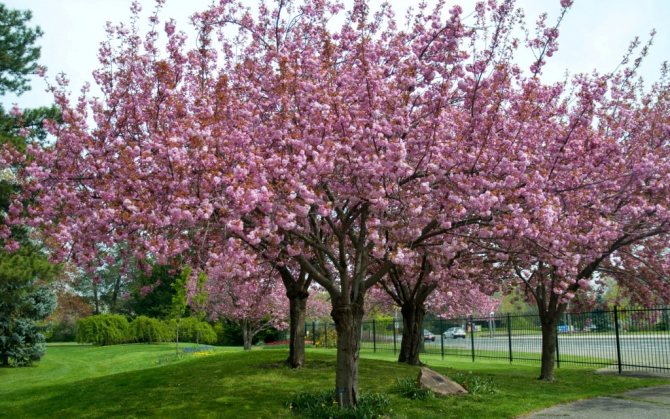

- Kiku-Shidare (weeping cherry or Japanese bird cherry) Flowering time - the end of March, the inflorescences are densely located on the branches hanging down to the ground. Fruits are edible, sour taste.
What the timing depends on
Factors affecting the appearance of the first peduncles and berries:
- Cherry variety.
- The quality of the planting material (seedlings).
- Planting conditions - choice of location, type of soil, time, depth of the hole.
- Young tree care.
- Correct pruning, crown formation.
- Weather (drought or frost, uncharacteristic for the region).
- The presence of pollinators.
Landing rules
Seedlings should be purchased from reliable sellers, paying attention to the condition of the roots and upper bud. Before buying, study the information about the variety.
Cherries are planted in spring, usually in April, when the ground is fully warmed up and the buds have not yet begun to bloom. Choose sunny, wind-free places. The land should be loose, fertile. It is preliminarily enriched with mineral and organic fertilizers.
Cherry does not like acidic soil, it is better to choose areas with neutral or close to it. The clay soil from the hole is mixed with sand.
After planting, the area around the trunk is mulched with sawdust, humus crumbs or similar material to prevent root drying.During the entire warm period, the soil under the seedling should be loose and free of weeds. When loosening, you need to remember that the roots are shallow, and not damage them.
Cherry care
Cherry is fertilized by the fractional method, 2-3 years after the first planting soil enrichment. Watering is carried out 3-4 times a year, depending on weather conditions. The first year of life is watered more often.
Many varieties have a dense crown and grow rapidly. There are different pruning schemes for bushy and tall varieties. Cut off shoots more than half a meter long. Otherwise, the tree will not stop bearing fruit, but the berries will become small and may lose their taste.
It is necessary to monitor the health of the bark and leaves, to eliminate diseases and pests in time.
The growth and fruiting of cherries are also influenced by neighboring plants. She is friends with cherries, elderberries, honeysuckle, plums, grapes. Peach and apricot, apple, raspberry, pear, wild trees with a powerful root system interfere with its development.
Cherry planting
For the rapid growth and fruiting of a cherry tree, it is important to choose a suitable site for planting it and determine the planting time, which depends on the region. You can plant young cherry seedlings in spring or autumn for the southern regions, and for the northern and central parts - in the spring.
Choosing a site
When choosing a site for planting a fruit tree, it must be remembered that a cherry does not tolerate a transplant, so in advance, think about a permanent habitat in the garden for it, where it will grow and yield for 15 years. Cherry trees prefer bright, well-sunlit areas of the garden or calm slopes; they should not be planted in lowlands where stagnant melt water occurs or in areas where groundwater is high. The soil for cherry trees should be sandy loam, loamy, light and slightly acidic. In case of increased acidity of the soil, the soil must be dug to the depth of the shovel bayonet, having previously sprinkled it with dolomite flour or lime (400 g per m²), and later, after a week, fertilize the soil, you can use compost or rotted manure (15 kg per m²). It is not recommended to add lime together with organic matter. When planting several trees, it is important to keep the distance between them - at least 3.5 meters, planting in a checkerboard pattern.
Planting in autumn
Autumn planting of cherries consists in dropping in the seedlings purchased in the fall. If the seedlings are planted in the fall immediately in the ground, they will not have time to take root before the onset of frost. Therefore, choose a shady place on the site where the snow does not melt for a long time in spring, dig a small trench at an angle of 45 º 30-40 cm deep, lay the seedlings in it at an angle, laying the roots and sprinkling them with earth. The roots, sprinkled with soil, must be watered abundantly. Cherry seedlings are covered with spruce branches so that they are completely covered, while the spruce needles should be outward to scare away rodents. As soon as it snows, cover the spruce shelter with snow before spring planting.
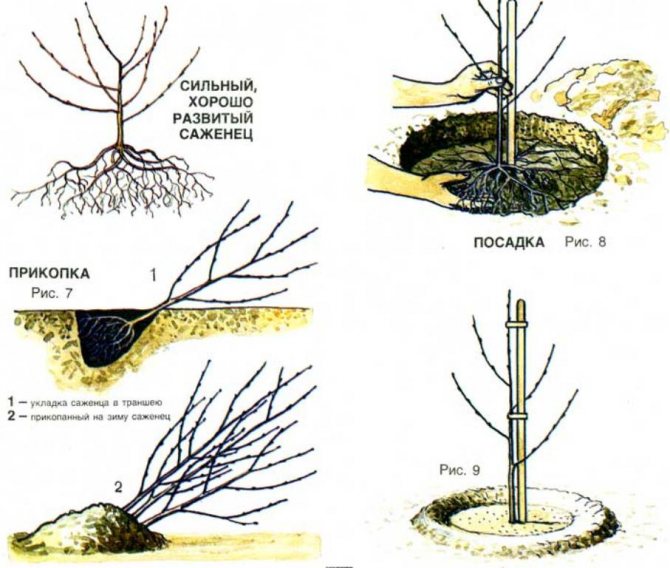

Spring planting
Spring planting allows the seedlings to take root well and begin active growth. Cherry seedlings are planted in mid-April in well-heated soil. Seedlings can be purchased in the spring, or you can dig them in in the fall, as described above. When buying, choose two-year-old trees, pay special attention to examining the root, if it is damaged or rotten areas are found, they must be trimmed and the cut points must be treated with powdered activated carbon. It is recommended to hold the roots of the tree in water for about 3-4 hours before planting so that they are saturated with moisture. The pit for planting seedlings should be 50-60 cm deep, up to 80 cm in diameter.The top layer of soil is mixed in equal amounts with humus, additionally, the following is added to the soil:
- 1 kg of ash;
- 30-40 g superphosphate;
- 20-25 g of potassium chloride.
If the soil is clayey, a bucket of river sand is added to it.
It is necessary to drive a peg into the planting hole, to which the seedling will be tied, in order to prevent damage from gusts of strong winds. The seedling is placed in a hole, the roots must be well spread and covered with soil so that the root collar is 3-4 cm above the ground level. The soil around the seedling needs to be well compacted and a hole for watering should be made. Within 2-3 days, a young tree needs abundant watering. It is recommended to mulch the soil around the trunk circle with sawdust or humus (layer 3-5 cm)
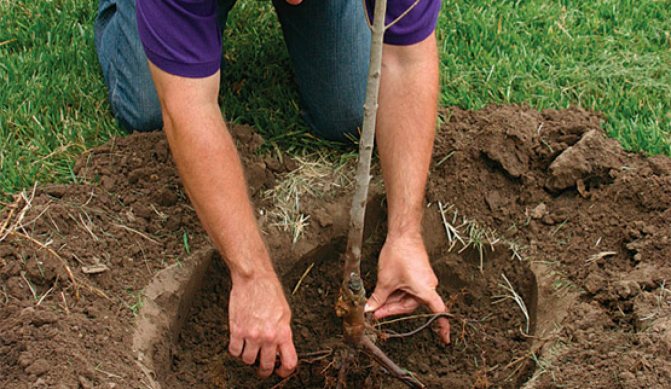

Features of growing cherries in the Moscow region
Growing cherries in the open field in the Moscow region has its own characteristics. First of all, you need to choose a place on the site. Cherry loves a lot of sun, so it should be planted in well-lit, sheltered from the wind places on the south side. The soil is suitable for it light, loamy and sandy loam, flavored with compost or humus, well-drained, without stagnation of water. If the subsoil waters are located close to the surface, above 1.5 m, then the tree will have to be planted on a bulk mound of at least 0.5 m in height.
If the soil has a pronounced acid reaction, which is not uncommon in the Moscow region, it should be neutralized with lime or dolomite flour to pH 6 in the fall or 15-30 days before planting, at the rate of 2 kg per 5 m2.
Attention! If the cherry belongs to the self-fertile species, then in order to obtain good yields, it is necessary to purchase seedlings of several varieties.
Cherry care
Throughout the season, young cherry trees need care, which is different from caring for an already mature tree. When caring for young trees, it is necessary to periodically loosen the soil around the trunk circle, removing weeds, watering and pruning in a timely manner. Fruiting mature trees need the following care: In the spring:
- abundant watering is needed, especially during the period of active growth of shoots and flowering;
- to attract pollinators in a rainy spring, trees must be sprayed with honey solution (1 tablespoon honey per 1 liter of water);
- loosening the soil;
- in early spring, before the buds begin to bloom, the root shoots are trimmed and the trunk circle is mulched with sawdust or compost;
- carry out preventive work on the processing and protection of cherry trees from pests and diseases. As a prophylaxis, a 3% solution of copper sulfate or Bordeaux liquid is used.
In summer:
- abundant watering is carried out, especially in dry summers;
- nitrogen fertilizers are applied in summer, and after 3-4 weeks - phosphorus and potassium, trees are treated with Fufanon and copper oxychloride;
- harvest as the fruits ripen
Autumn:
- as soon as the leaves begin to turn yellow, after watering or precipitation, organic matter and mineral fertilizers are introduced into the trunks.
- produce pruning.
Wintering cherries:
Adult trees, especially winter-hardy varieties, do not need winter shelter, unlike young ones. The trunks of young trees for the winter must be tied with spruce branches, before that they have been whitewashed in autumn with a solution of lime with copper sulfate.
Harvesting and using the crop
For a long time there are no 400 cherry orchards in Vladimir, but Vladimir cherry is still widespread throughout the Russian expanses, especially in the middle lane. Indeed, with good care and favorable weather conditions, up to 20-25 kg of wonderful cherries can be harvested from an adult tree. In the northern regions, the yield will be much lower, no more than 5 kg per tree.
The excellent taste of Vladimir cherry has already been mentioned, for lovers of dry numbers, we note that the fruits contain:
- sugar - 10.9%;
- acids - 1.7%;
- vitamin C - 26.6 mg / 100 g of pulp.
Harvesting begins in mid-July and moves on to August, as the fruits do not ripen at the same time.For the best preservation of cherries, they should be removed with a stalk and placed in the fruit compartment of the refrigerator, previously packed in plastic bags. They can stay there for two weeks. Cherry blanks are traditional: jam, juices, compotes, jellies, pie filling, and let's not forget about cherry liqueur.
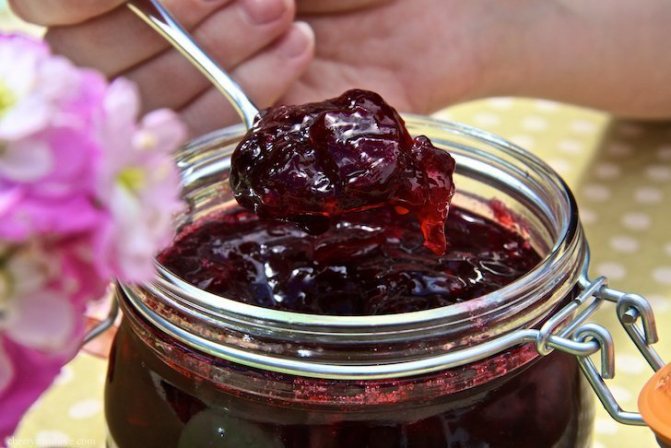

Cherries make amazing jelly
By the way, cherry juice has an antipyretic effect, and melatonin contained in fruits regulates the daily rhythms of the body, and a couple of dozen fruits eaten at night will make you sleep more sound. There is enough iron in cherries, which means that their use increases hemoglobin and blood clotting. Therefore, the best way to use the cherry harvest is to consume it fresh.
Cherry pruning
When to prune cherries
Cherry pruning is an important step in plant care, on which its yield depends. The first pruning is done in March, before the buds swell and the sap begins to flow. In case of late spring pruning, it is better not to produce it, but to postpone it until summer, after harvest, otherwise the branches will simply dry out. Correct pruning of excess branches in the spring will improve the tree's yield. Autumn pruning of cherries is carried out at the end of the growing season, it helps the trees to better endure frost and cold. Sanitary pruning to remove damaged, diseased or dry branches is carried out throughout the season.
How to prune cherries
Cherry is an early ripening fruit tree that begins to bear fruit early, so regular pruning allows you to prolong the tree's youthfulness longer and avoid rapid depletion. Correct pruning of branches gives them more strength for the formation of fruits and increases the yield of the tree many times over. The older the tree, the more carefully the pruning is done.
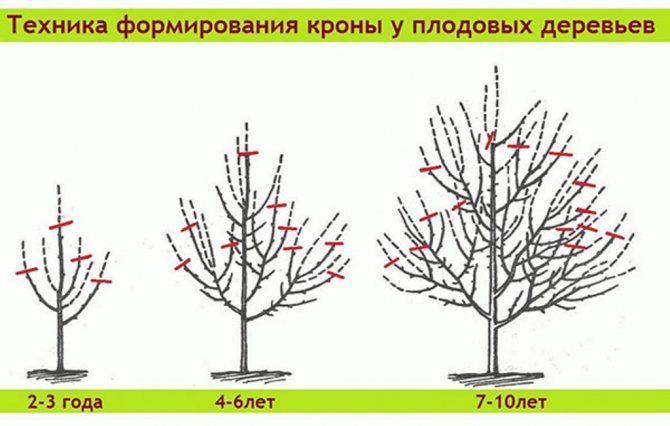

How spring pruning is done
- Pruning is carried out in April, during the swelling of the buds, when it is already clear which branches have not survived the winter, which are removed. Also, spring pruning contributes to the formation of the crown. Spring pruning stages:
- Removing those tree branches that thicken the crown. Branches that stretch upward are removed to the very base. Those branches that run parallel to the ground are left.
- Shoots up to 30 cm long - not cut. Pruning should be those branches that interfere with the growth and development of other branches.
- Undercutting the main trunk. It should not rise more than 20 centimeters above the main skeletal branches.
How to prune cherries in summer
Pruning in the summer consists in slightly adjusting the crown of the tree, removing damaged or diseased branches.
How to prune cherries in the fall
Pruning in the fall prepares the tree for a long hibernation; the timing of the work depends on the region. For southern latitudes, the pruning time can last until November, and for the northern regions it is recommended to carry it out in mid-September, so that the cuts have time to tighten, before frost. The branches of young seedlings are not pruned in the fall. Stages of work:
- It is necessary to remove large branches that prevent other branches from developing. The skeletal branches forming the crown are not trimmed.
- Do not prune small branches in the fall, postpone pruning until spring.
- Before pruning a branch, it is necessary to plan for its replacement, which will rejuvenate the plant and maintain the yield of the tree.
- After pruning in the fall, cherries should not have sharp branches.
- Slices must be treated with a varnish or other special means.
Gardening Tips:
- Tree varieties of cherries must be shortened gradually, do not cut off all the shoots at once, this can injure the tree.
- If cherry branches grow fast enough (40-50 centimeters per year), they should not be thinned out. If the growth of the tree has decreased, it is worth pruning those branches that do not give new branches during the season.
- Branches of bush cherry varieties are shortened by 50 cm. Cutting of skeletal and secondary branches is carried out in 2 stages. If this year the frame branches were pruned, then it is better to prune the secondary branches in the next season. Particular care should be taken when pruning young growth, so as not to remove the fruitful branches.
- When pruning branches of young trees, use a garden saw or knife, pruning shears are suitable for mature trees.
Cuban cherry. How to grow it?
Indoor nightshade has up to fifty species. The decorativeness of these plants is undeniable: during the fruiting period, the plant is strewn with large, up to 1.5 cm in diameter, bright, shiny, orange-red berries. Decorativeness is enhanced by the fact that the plants simultaneously contain white flowers and berries of varying ripeness.
The fruits of most types of nightshade are inedible and can be poisoned. But what is interesting, despite the toxicity of the fruit, indoor nightshade is often called Chinese cherry, indoor cherry, Cuban cherry, Jerusalem cherry. There is also a nightshade with black edible berries. At home, in South America, they are used in baked goods.
In European countries, indoor nightshade is often a home decoration for Christmas instead of a Christmas tree. Shiny, orange-red berries against a background of dark green foliage create a fabulous mood. You should remember about the toxicity of the fruit and do not start this plant if there are small children in the house - the temptation to try bright berries is too great.
In indoor floriculture, two types are most common: pepper-shaped nightshade and false-pepper nightshade. In the first species, the leaves are narrow-oval, dark green, star-shaped flowers are white in color, the fruits are berries with an orange-red color. Its dwarf forms are popular - the height of the bush is up to 30 cm. In the pseudo-pepper nightshade, the leaves are shorter, and the fruits are larger. The plant reaches 70-75 cm in height and looks more impressive than pepper-shaped nightshade.
Some herbalists consider the fruits of the pepper-shaped nightshade not so poisonous and use them in the treatment of sore throat. The juice is used to absorb boils, heal wounds and cuts. This nightshade is sometimes called a sore throat, a sore throat tree. But it seems that it is not worth experimenting - there are enough of our own, proven medicinal plants growing in our localities.
Indoor nightshade is considered a rather unpretentious plant. True, certain conditions of detention must be observed in order to get a beautiful, abundantly flowering bush.
The nightshade requires a lot of light, but it is advisable to shade from the midday rays so that there are no leaf burns. In summer, if possible, keep outdoors.
The optimum air temperature is 18-25 degrees. It tolerates an increase in temperature of up to 30 degrees well, while it is necessary to provide the plants with sufficient moisture: put in a pallet with expanded clay, which should always be wet, spray regularly. In winter, keep at a temperature of 12-16 degrees, then the berries and leaves will last longer.
In order for the indoor nightshade, which is considered an annual plant, to extend its life, at the end of winter, early spring, it should be transplanted and cardinal pruning should be done. Before this procedure, the bush should not be watered so that it sheds foliage and fruits. If you give the plant a conical shape, then it will look even more like a Christmas tree.
Indoor nightshade loves abundant and regular watering in the summer, it quickly uses nutrients, so it should be fed weekly with fertilizers for flowering plants. In the autumn-winter time, it is enough to feed once a month.
If the plant is blooming, and the fruits are not tied, it is necessary to make artificial pollination with a brush.
Spider mites and aphids can attack nightshade. In this case, insecticides are indispensable.
It is better to propagate nightshade by seeds, then you get stronger, well-bearing plants. Experts recommend sowing seeds in February-March to a depth of about a centimeter. The soil is suitable for this: peat soil, clay and a little sand.
Seedlings appear within ten days. When the plants reach ten centimeters, they pinch the tops. Starting in spring, you can form a bush by removing excess lateral shoots, pinching.
Flowering begins in summer, and mass fruiting begins in autumn. The berries stay on the bushes throughout the winter.
You can propagate indoor nightshade and cuttings, they root well in wet sand.
Settle this nightshade miracle in your apartment, and you will be in a festive New Year mood!
Tags: poisonous plants, cultivation, floriculture, houseplants
Diseases and pests
- Brown spotting. The leaves are covered with yellow reddish spots, dots appear on them, which eventually dry out and crumble, forming holes in them, later the leaves fall off. Treatment is carried out by introducing 1% Bordeaux liquid into the soil.
- Clasterosporiosis (perforated spotting), In this disease, not only the leaves are affected, on which brown spots appear, but also the fruits, on which neoplasms similar to warts are formed, the buds on the branches turn black. The affected areas of the branches must be removed and disinfected with 1% copper sulfate.
- Coccomycosis. With a disease, the leaves become covered with red dots, then they turn brown and fall off. After flowering, the tree is treated with Horus (2 g per 10 l of water), repeat the procedure after three weeks, the third time - three weeks after harvest.


- Witch's broom is a fungal disease that leads to the formation of many sterile shoots, and the foliage becomes pale, shrinks and wrinkles over time. At the end of the summer season, a gray bloom is observed on the lower part of the leaves and the spores of the fungus are clearly visible. The branches affected by the disease must be removed, the tree must be treated with 5% ferrous sulfate.
Cherry pests:
- Plum moth. Its caterpillar devours fruits. Fruit trees are treated with Cytcor, Anometrine.
- Cherry weevil. A green beetle with a raspberry sheen that damages buds, buds, ovaries and foliage. A female bug is dangerous, which is laying eggs in a bone, from which larvae appear, eating away the nuclei of the bones. Damaged berries fall off. It will help get rid of the pest Ambush, Rovikurt.
- The subcrustal leafworm lays eggs in the bark of a tree, its caterpillar damages the bark by gnawing holes in it. To combat it, a 10% solution of Karbofos is used, during the invasion of butterflies.
- Cherry aphids are one of the most dangerous pests of cherry trees. Their vital activity leads to the curvature and cessation of the growth of young shoots, to curling of leaves, and a decrease in the cold resistance of young trees. The fight against aphids begins with spraying in early spring with Karbofos, Aktellik, Rovikurt or Ambush.


Observing all the rules for planting and caring for cherries, as well as with regular and correct pruning of trees, you will receive an unusually rich harvest of healthy and tasty berries for many years. A fragrant blooming cherry orchard will delight you every spring, decorating the garden area with lush flowering.
Experienced gardening tips
Agricultural technology for growing cherries in the Moscow region is not too complicated, it is available even for novice gardeners. The unpretentiousness of cherries, as well as the benefits of its berries, determine the popularity of this tree in Russia. Experienced gardeners share the secrets of successfully growing cherry trees in risky farming zones with harsh winters:
- Saplings should be zoned, grown in a nursery specifically for the Moscow region.
- An excellent solution would be to plant on the southern slopes of the hills, as well as on the southern side of the fence, at home, stepping back from it at a distance of at least 2.5 m so that the roots do not damage the foundation.
- Snow is an excellent protection against frost. Young seedlings tolerate harsh winters well under a pillow of spruce branches and snow.
- If possible, it is better to purchase seedlings with a closed root system, in pots or special bags. In this case, the seedling is carefully rolled into the prepared hole, trying not to disturb the lump.
- The neighborhood in the garden is very important: this way the trees get sick less and bear fruit more abundantly. Cherry does not tolerate planting next to cherries, apple trees, pears, black currants.
- Saplings should be 1-2 years old. Older trees do not take root well.
Important! On the day of planting seedlings, the air temperature in the Moscow region should be at least 5 degrees Celsius.
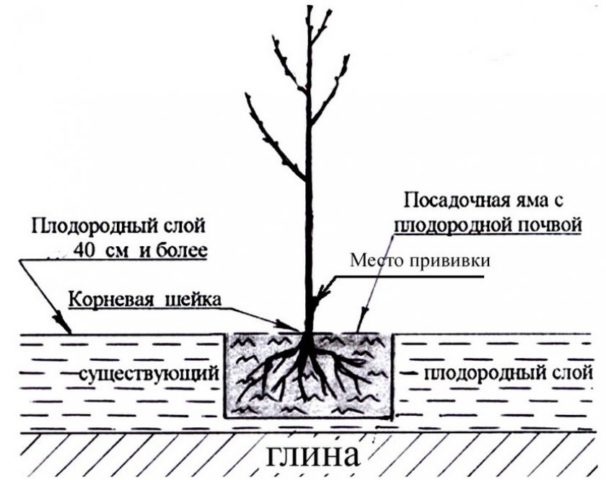

Scheme of the correct planting of cherries in the Moscow region
Cherry tree propagation
The seed propagation method for cherries is very rarely used. Several other ways are acceptable for this type of fruit crops:
- Cuttings. Choose the strongest trees from which the material is taken. Use green shoots located on the south side of the tree. It is best to harvest cuttings before the onset of hot days, at the end of June. The upper part is removed from the cut shoots, and a 10-12 cm long stalk with well-developed four leaves is formed from the remaining branch. The material is planted in a box, deepening it by 3 cm.The distance between the cuttings should be at least 7 cm.
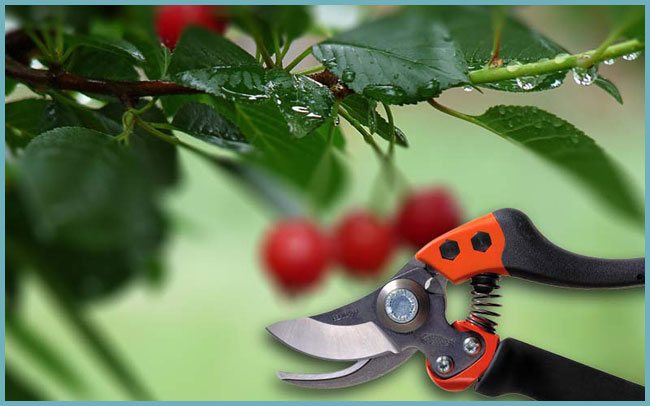

Cutting is a common way of propagating cherries - Root shoots... From the stem of the mother plant, at a distance of 1 m, it is necessary to dig out the root cutting. Having tilted it a little, they add it in. After a while, a young shoot appears on it. After the plant is formed, it can be planted in the garden area.
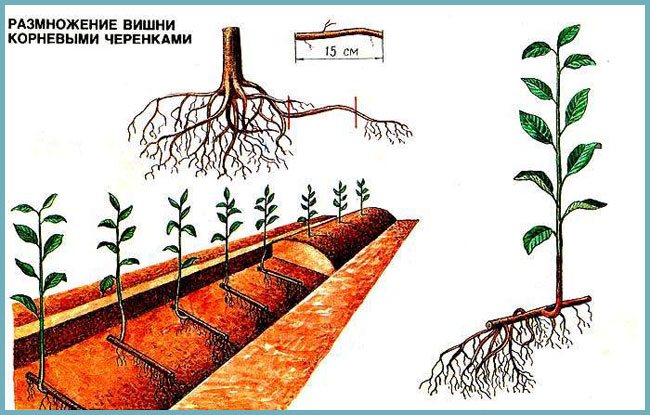

Cherry propagation by root cuttings - Graft... The rootstocks specially grown from seeds are grafted onto a young tree in several ways:
- in the side cut;
- for the bark;
- cleavage.
Why cherries do not bear fruit
Cherries may not bear fruit for the following reasons:
- Poor pollination - if there is no pollinator variety in the garden, then you should forget about good harvests. You can fix this problem by planting several of these trees.
- Fungal diseases - if you start this disease, then the plant will not only not bear fruit, but will die altogether. Therefore, when the first signs of rot appear, the tree should be treated with a Bordeaux mixture and the infected areas should be removed.
- Unsuitable climate - in order not to be faced with a lack of fruit, you should choose only those varieties that will bear fruit in the corresponding climatic zone.
- Lack of essential substances in the soil - timely application of fertilizers and maintenance of optimal soil acidity will solve this problem, as well as prevent its occurrence.
- Tree condition - untimely pruning or its absence also becomes the reason for minimizing yield. Performing this procedure in the next season will help correct the situation.
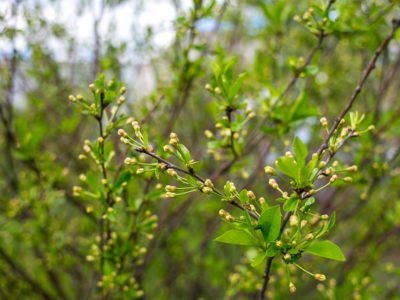

Planting pit formation, soil preparation
Planting pits are prepared in advanceat least 15 days in advance. The recommended arrangement for bushy varieties is 2x2, for tree varieties 3.5x3.5. The optimal pit size is 50x50x50.
You also need in advance prepare soil mixture for filling the pit... To do this, use the top layer of soil, deposited after digging a hole. It is mixed with nutrients:
- humus 1 bucket;
- potassium sulfate (30 g);
- superphosphate 200 g
The heavy soil is structured by adding 2 buckets of river sand. A drainage layer of expanded clay is laid at the bottom of the pit and 1/3 of the pit is covered with prepared soil, well compacted.
Also it must be remembered that nitrogen is found in large quantities in chicken manure and pig manure.
Choosing good seedlings
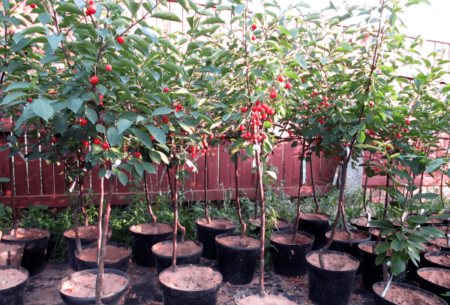

When choosing a seedling, you need to be guided by the following indicators:
- annual length - from 70 to 80 cm;
- the length of a two-year-old is from 110 to 120 cm;
- development of the lobe of the root system - from 25 cm and above;
- whole, mature wood.
You should not buy too high planting material. This is a sign of overfeeding with nitrogen fertilizers. Such trees can die in frost.
As already mentioned, there are own-rooted cherry varieties that can bear fruit without the help of pollinators. However, grafted varieties enter the fruiting phase earlier.
Spring and summer care, preparation for winter
If there is no regular precipitation in summer, you need to make a hole around the tree for watering, and fall asleep with the appearance of frost, otherwise water will stagnate there.
Until a steady cold snap the tree trunk circle of the seedling needs to be mulched with peat or sawdust a layer of 10-15 cm and spud the seedling to a height of 30 cm.
The branches of the tree are tied tightly to the stake with soft material. The barrel is tied with warm breathable material, lay a garden net on top and cover with a dense layer of spruce branches.
In the spring, you need to carry out uncooling and preventive treatments from bacterial and fungal infections. Before awakening the buds, it is necessary to cut the conductor and each branch by 1/3. This is done to regulate the ratio of roots and aerial parts, which is disturbed when the seedling is excavated.
With this approach to open field planting cherries develop disease resistance in advance, and with regular preventive measures, infections have practically no chance.
Thus, the basis for stable fruiting and an abundant harvest and longevity of the fruit tree is the correct planting in the country and the survival of the seedling.
therefore this event needs to be taken especially carefullyplanning each stage in advance.
How to make it bear fruit
The property of cherries that you need to know is that flowers on the same tree are often not pollinated from each other, in hybrid varieties - in isolated cases. Therefore, if it is already blooming, but the berries are not tied, you need to plant a pollinator tree nearby. Different pollinators are suitable for different varieties, in non-hybrid varieties it may be a copy of the same variety, and sweet cherries are also suitable.
Cherry is a fruit tree belonging to the Pink family, a genus of Plum. The oldest representative of this species is a cherry variety called Ptichya Cherry, but today this variety is better known as sweet cherry. The homeland of this culture is the territory of Denmark, Switzerland and Asia Minor. Today, fruit cherries are widespread almost all over the world; they are grown on an industrial scale in Iran and Turkey.
Choosing a place
A lover of bright, well-cared for by the sun areas, not blown by the winds. Favorably refers to sandy loam, loamy, clay soils. Hates cold winds from the north, which often blow over her when planting in lowlands.
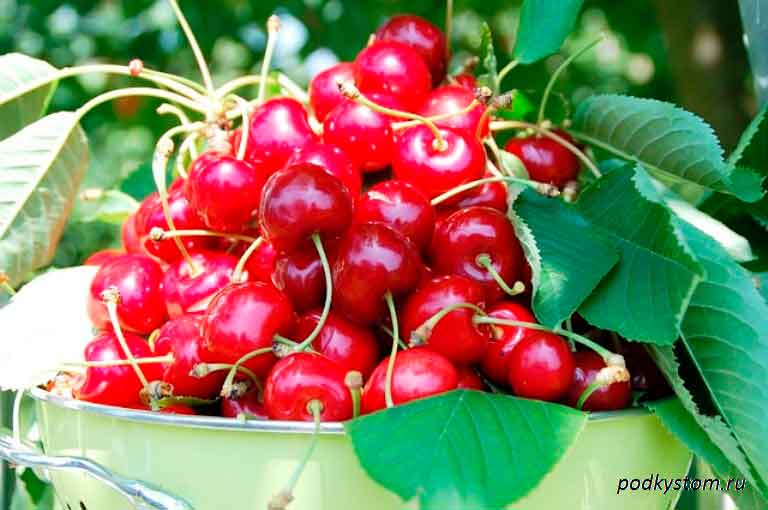

If possible, place the cherry on the low southern slopes. This gives them a better chance of not freezing during the flowering period.
An important factor in cultivation is the crop's request for cross-pollination. Hence, planting one tree is indispensable, unless it is self-pollinated.
The best time for planting is spring, but no one forbids doing this in autumn. If you suddenly did not manage to plant in the fall, it's okay, it will be enough to dig the seedling into the ground, leaving it there until spring arrives.
Crown formation
Young cherry pruning - first year... Cherry pruning scheme is pretty simple, unless you are going to give the crown some special shape. It all starts with shortening the top of the one-year-old by 18-22 cm.This is done not in early spring, but in mid-June, when young growths slowly begin to appear from those buds that you left behind.
First you need to visually determine the so-called standard zone on the seedling. Usually this is a part of the seedling from the root collar (in other words, from the soil level) and up to a height of 45-50 cm.The stem should be naked: all shoots growing from the buds on it must be removed immediately.
And from those shoots that grow above the trunk zone, you should choose five of the strongest and evenly distributed along the cardinal points. These will be the skeletal branches of your cherry tree. The topmost shoot, especially if it is a little crooked, be sure to tie it to a peg.
It is better to stick the pegs into the ground during planting of the seedling - this way there is no risk of damage to the root system.
All shoots that are located between those that you have chosen as skeletal must be cut into a ring, without leaving a hemp.
Pruning is not only a series of sequential actions, but also their correct execution. Learn to trim so that there are no stumps left. In appearance, they are harmless, however, as the tree grows, they can begin to rot, fall off, and hollows almost always form in their place. An infection can easily penetrate them, which will destroy the tree. Do not forget about the garden brew, this is a friend and faithful assistant to the gardener - for any types of pruning, at any time of the year, all cuts must be covered with them.
In the future, it is important to constantly regulate the growth of side shoots. Ideally, those higher up should be shorter than those growing lower. Remember the Christmas tree principle? It's the same with cherries. This problem can be solved by simply pinching the tops of the upper shoots. After that, the branches will grow to the sides and will not stretch.
Pruning a cherry sapling in the second year... Choose from the total mass of shoots 5-6 well-developed, strong branches that extend from the main trunk at an angle of 40 ° or more (the more, the better). It is these shoots that will be the skeleton formers of the crown.
Do not forget about the subordination of those shoots that you have chosen to the central conductor - the ends of these branches should be at least 25-30 cm below its top.
All other shoots need to be shortened by no more than 8-10 cm. But if in the future you notice that they interfere with each other or thicken the crown, then they can be cut “into a ring”.
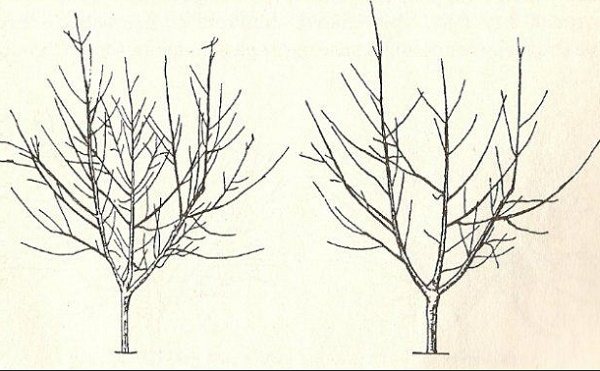

This is what a cherry sapling looks like after pruning in the 2nd (left) and 3rd year (right)
Cherry pruning in the third year... Starting from the third year, it is no longer a pruner that is used, but a garden saw. Here you do not need to shorten much, you should, like a stone master, only cut off all unnecessary things, thin out. The shoots that have grown strongly in a year can be shortened by 8-10 cm, but only if the length of the growths is at least 60 cm. Of the shoots that have grown in the current year, leave 1-2 of the strongest and most well-located shoots. Delete all others.
Cherry pruning for the fourth year... In the fourth year, you need to deal with thickening, because young cherry trees grow quite actively. Remove shoots growing deeper into the crown, and follow the subordination of the central conductor (cutting off those that are equal to it in length or outgrown). As in the previous year, of the young shoots that have grown, leave 1-2 of the most well-located and not thickening the crown.
Often gardeners ask the question - what to do with the dangling shoots? In cherries, by the way, this phenomenon is common. We answer: first, they need to be raised and tied to a higher shoot. If this fails, you can delete them.
Cherry pruning for the fifth year... And, finally, the fifth year of formation - we continue to cut off all unnecessary, and by the end of the season your tree should have about ten well-developed skeletal branches.
We memorize the rules of an ideal cherry tree - subordination (branches are shorter than the central conductor) and tiering (lower branches are longer than upper ones).
What to do with cherries next? In the first years of fruiting, corrective pruning is necessary - if you saw a shoot that is longer than 50 cm, shorten it to 45-50 cm.
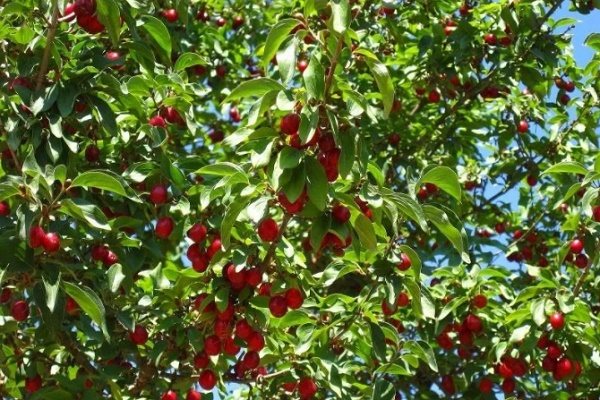

How to do anti-aging cherry pruning? With age, trees, like humans, start to have problems. In cherries, for example, the growth rate decreases, the shoots become bare, the fruits are formed only at the edge of the crown, the lower branches dry out.All this is a signal that it is time for the tree to radically rejuvenate.
With such pruning, they are guided by the growth rate in recent years, and if it was weak, the growth is removed without regret, to the level of four- or seven-year-old wood, trying to make all the cuts on the lateral branch (so that new shoots grow not inward, but outward of the crown, freeing Centre). Do not forget to remove with a cut "on the ring" and all shoots that thicken the center of the crown.
After such pruning, the cherry can literally "shoot" shoots, form many tops (they grow vertically upward and will not bear fruit in this form). You do not need to try to remove all tops, it is better to try to bend them, tying them to the lower shoots, or shorten them so that they begin to grow sideways.
Beneficial features
Consider why it is useful to have cherries in your garden and what riches are hidden in its fruits:
- Cherry drupes are rich in organic acids such as malic, succinic, salicylic and others.
- Berries are rich in vitamins A, C, PP, B2 and B9.
- Fruits contain minerals and trace elements: calcium, iron, phosphorus, magnesium, potassium, copper.
- They contain a lot of glucose, fructose, pectin substances, anthocyanins, tannins, etc.
- Cherries are used to treat the nervous system, some stomach diseases, bronchial asthma, etc.
- Cherry fruits are used to strengthen the immune system.
Cherries are a real treasury of various useful elements, so they simply must grow in the garden and bear fruit.
Prevention of pest attacks on cherries
To suppress the vital activity of pests that damage cherries, preventive measures should be taken regularly.
To prevent insect attacks, all agrotechnical rules must be observed (watering, weeding, loosening, pruning, mulching, etc.). Treatment of plants with special chemical compounds (fungicides) is of great importance. They not only inhibit vital activity, but also destroy insect pests.
Cherries are unique fruit trees whose fruits have a positive effect on the human body. Even a novice agronomist can grow fruitful and healthy trees. But in order to get good yields, you will need to study the basic rules of agricultural technology and follow them.
Probably every person who even has a small piece of land near the house would like to build a garden there. Cherries are one of the most popular garden trees. Sometimes it is confused with cherry, but these are different plants. This culture is distinguished not only by its useful properties, but also by its beauty. To provide the tree with proper care, you need to know what year the cherry is bearing fruit after planting.
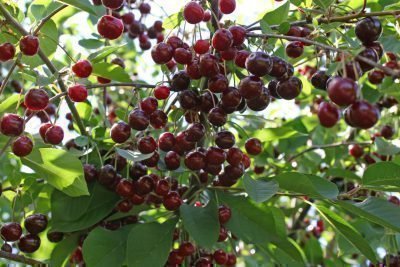

Proper watering
Trees planted in spring expect careful care from us, and most importantly, frequent watering.
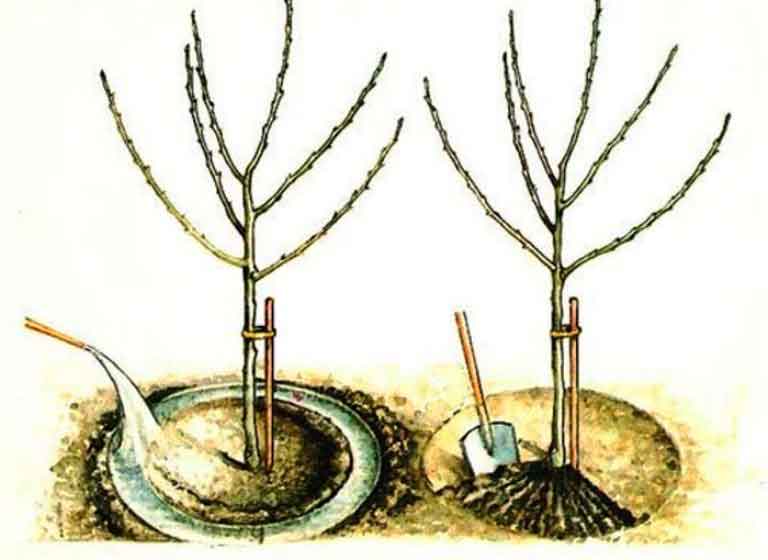

We spend 2-3 buckets on one young plant during the period of shoot growth (early June). And a tree at the time of filling and ripening of fruits requires itself 25-35 liters, but it is necessary to focus on the weather. After all, an excess of moisture leads to cracking of the fruit.
In hot weather, watering is carried out 2 times a month.
September - October - you can carry out a water charging strait. We spill well so that the soil is moistened to a depth of 40 cm.

